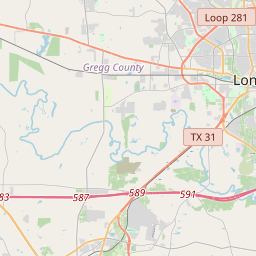Gregg County Courthouse
101 E Methvin St #109, Longview, Texas






Built in 1932 in Moderne architectual style by architect Voelcker & Dixon by contractor C.S. Lambie.
Six storey brick, terra cotta and marble courthouse that reflects the character of municipal buildings of the period with its adherence to the design motifs of the Art Moderne style. The courthouse is conceived as a series of rather blocky forms, with ornamentation confined to the main entrance bay and to the spandrel panels between floors. As was often the case with 1930's courthouses in Texas, the county jail was incorporated into the design, being located above the offices and courtrooms in the tallest section of the building.
#NAME?
Current status: Active Courthouse
The Texas Historical Commission's (THC) nationally recognized and award-winning Texas Historic Courthouse Preservation Program (THCPP) has turned around the trend of disrepair and begun restoring these treasured historic landmarks. Texas has more historic courthouses than any other state. Today more than 240 courthouses still stand that are least 50 years old. About 80 were built before the turn of the 20th century. By the end of that century, most of these structures were significantly deteriorated due to inadequate maintenance, insensitive modifications or weather related damage. The Texas Historical Commission (THC) documented the condition of 50 of the state’s oldest courthouses in the late 1990s and determined that counties lacked the resources to preserve the buildings for future generations.
Texas was once an independent country: After winning its independence from Mexico in 1836, Texas became its own country, known as the Republic of Texas. It existed as an independent nation for nine years before being annexed by the United States in 1845.
In 1839, Gregg County was established as part of the Republic of Texas, named after Texas Confederate States Army General John Gregg. The county grew slowly over the next few decades, with agriculture and cattle ranching being the primary industries. The discovery of oil in East Texas in the early 20th century brought significant economic growth to Gregg County. The prolific East Texas Oilfield attracted oil companies and workers from across the country, leading to a population boom.
During World War II, Gregg County played a crucial role in the war effort. The county's industrial base expanded rapidly as several defense plants were established in the area. The influx of workers and industries contributed to the county's postwar growth and prosperity.
Since then, Gregg County has continued to develop and diversify its economy. It is known for its agriculture, oil and gas production, manufacturing, and healthcare industries. The county is home to the city of Longview, which serves as the county seat and is a major cultural and economic hub in East Texas. Today, Gregg County boasts a rich history, a thriving community, and a promising future.
Gregg County Timeline
This timeline provides a concise overview of the key events in the history of Gregg County, Texas.
- 1841 – The Texas Congress establishes Gregg County as a county in the Republic of Texas.
- 1846 – Gregg County becomes a part of the United States as part of the state of Texas.
- 1849 – The city of Longview is established as the county seat of Gregg County.
- 1861-1865 – Gregg County residents participate in the American Civil War, with many men serving in the Confederate Army.
- 1872 – The Longview and Pacific Railroad is completed, connecting Gregg County to the national railway system.
- 1873 – The first public school in Gregg County opens in Longview.
- 1930s – The discovery of the East Texas Oil Field leads to an economic boom in Gregg County.
- 1936 – The East Texas State Teachers College (now known as Texas A&M University-Commerce) opens a branch in Longview.
- 1980 – The Longview Mall, the first enclosed shopping mall in East Texas, opens in Longview.
- 2006 – The East Texas Oil Museum, showcasing the history of the oil industry in the region, opens in Kilgore.